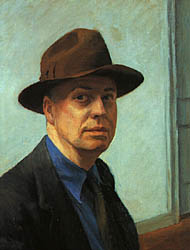Magic Realism in the Americas - Part 1

|
There has always been a strong tradition of realism in American art.
Far away from the cultural centers on Continent Europe and separated by
the Atlantic, the American brands of realism flourished and
dominated the art scene for the 300 years leading up to the 1950s.
This included works of many genres, some of which we will list here:
Early Realists
- Benjamin West, John Singleton Copley
Naive style
- Edward Hicks, Ammi Phillips
Still Life
- Raphaelle Peale, William
Michael Harnett
Frontier art
-
George Caleb Bingham, George Catlin
Landscape - Frederic Edwin
Church, Albert Bierstadt, Thomas Moran
Marine Art - Fitz Hugh
Lane, Winslow Homer
Later Realists
- Thomas Eakins,
Thomas Anschutz
Ashcan School
- Robert Henri, George Bellows
From the time of the Revolutionary War, the development and continuity of
Realism in America was rarely impacted by war or social upheaval.
Additionally, after the turn of the twentieth century, American artists
remained independent from the rapid evolution of short lived
"movements" that developed in Europe up until World War II. These
styles, including the various forms of Cubism and various brands of
Surrealism, were the focus for much publicity and at least
partially the invention of the art dealers, particularly in Paris.
American artists and dealers only slowly became involved in the
production of "fashionable art".
American artists in the early decades of the twentieth century were
not isolated from developments in Europe. Many of them went to
Europe
 for
periods of time to study, often early in their careers. But they
returned, each to develop an individual style. This was the case for
the remarkable realist, Edward Hopper, who tapped the loneliness of
era of the Great Depression in a particularly poignant way. Hopper
painted scenes in both the cities and the countryside, using strong
shadows and complex lighting to develop static, yet deeply emotional
art. Some writers who have studied the art of Neue Sachlichkeit feel
that his work is related. If not completely so, it is on a emotional level. for
periods of time to study, often early in their careers. But they
returned, each to develop an individual style. This was the case for
the remarkable realist, Edward Hopper, who tapped the loneliness of
era of the Great Depression in a particularly poignant way. Hopper
painted scenes in both the cities and the countryside, using strong
shadows and complex lighting to develop static, yet deeply emotional
art. Some writers who have studied the art of Neue Sachlichkeit feel
that his work is related. If not completely so, it is on a emotional level.
Charles Sheeler, who is known as the main practitioner of the
Precisionist School, is another artist that some writers say is
related to Neue Sachlichkeit. His landscapes and industrial art are
carefully drawn and finely painted works that have almost the
realism of a photograph. Yet for all Sheeler's passion for the
detail, these images are the impersonal, almost dehumanized. Both
technically and aesthetically they seem to have kinship to German Magic
Realism, particularly to the work of Franz Radziwill.
Grant Wood is another American artist who spent time%201930%202a.JPG) in Europe studying art. In his case it was the art of the
Flemish and German masters. Many historians designate his work to
the branch of American art called Regionalism. However, much of Wood's
work has a satirical bend, which is contrary to the Regionalist
philosophy. Beginning
in 1928, on his return from a trip to Bavaria, his work changed
stylistically, influenced by contemporary German art. He was greatly
impressed by the
Flemish miniatures that he saw during his visit. From this time on,
his paintings showed sharp detail throughout and a strong relationship between the subject and the background. From 1928 until his death in 1942,
Wood created a strong portfolio of Magic Realism .
in Europe studying art. In his case it was the art of the
Flemish and German masters. Many historians designate his work to
the branch of American art called Regionalism. However, much of Wood's
work has a satirical bend, which is contrary to the Regionalist
philosophy. Beginning
in 1928, on his return from a trip to Bavaria, his work changed
stylistically, influenced by contemporary German art. He was greatly
impressed by the
Flemish miniatures that he saw during his visit. From this time on,
his paintings showed sharp detail throughout and a strong relationship between the subject and the background. From 1928 until his death in 1942,
Wood created a strong portfolio of Magic Realism .
In 1943 the Museum of Modern Art in New York held an exhibition
entitled "American Realists and Magic Realists". The catalog
included works by Edward Hopper and Charles Sheeler, along with
those from twenty six young artists from that period. These artists
were to form the backbone of the American phase of Magic Realism .
We have included examples of work by most of these artists in our
special gallery American Magic Realism.
Our discussion of American Magic Realism continues in part 2.

Neue Sachlichkeit Gallery
European Magic
Realism Gallery
America Magic Realism
Gallery
Chapter 1 - Magic Realism Introduction
Chapter 2 - Roots of Magic Realism
Chapter 3 - Neue Sachlichkeit Artists
Chapter 4 - Surrealism vs Magic Realism
Chapter 5 - Magic Realism in other European
countries
Chapter 7 - Magic Realism in the Americas (2)
Chapter 8 - Contemporary Magic Realism
Chapter 9 - The Future of Magic Realism
Email:
dreams@tendreams.org
|